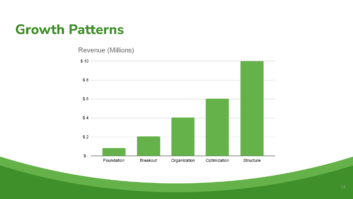How many different streams of revenue does your company have? One? Two? What would happen if one of them dried up? Are all of your eggs in one basket?
According to many economists, 2018 will usher in a mild recession. There’s no better time than now to get your house in order and protect your company from market volatility. Consider stress testing your company today by hypothetically removing a large client or market segment. What would it take to replace that revenue? Now consider adding that revenue immediately so you’re not caught off guard. Here are a few revenue stream opportunities with potential pros and cons:
Large Residential Jobs: These are the jobs we all like to talk about and, indeed, they provide the lion’s share of revenue for most CI businesses. Relying exclusively on large residential jobs, however, puts you at the mercy of luxury spending whims and could suffer in a downturn. Prospecting and predicting large jobs can be tricky, as well. More often than not, it’s common to find many large jobs converging at once and consuming much of your company’s resources. High-end customers are demanding and can expect more than your company is able to provide. Be careful to under promise and over deliver and realize that every dollar you spend on design and engineering up front will save you thousands in lost labor revenue down the road.
Commercial: It’s tempting to look over the fence and covet projects involving conference rooms, digital signage, unified communications, and more. Step carefully, though, as most commercial work is sold at lower margins than the 40-plus-point residential world. It’s not uncommon to hear about large projects with sub-30-point margins and aggressive deadlines. Find a niche in the commercial world and plant your flag to get started. Reputation, a solid back-office workflow, and deep team bench are essential to producing great results on commercial projects. There are many residential CI companies who’ve made the leap and now produce more than 50 percent of their annual revenues in the commercial world.
Security Monitoring: This one is a no-brainer. Your clients need security systems. Recurring Monthly Revenue (RMR) is a solid way to diversify your income and while it builds slowly, it’s not uncommon to see CI companies with hundreds or thousands of accounts able to absorb a work slowdown or recession. The sooner you start, the sooner you’ll arrive. Companies like alarm.com and organizations like ESA and CEDIA can train your team quickly and efficiently to deliver happy customer results.
Managed Services: While a new category, the economics of rolling trucks for service calls do not make sense for a CI company or its customers. It’s expensive and inconvenient to service systems on site, and there are many tools like Ihiji, Domotz, OvrC, and BakPak to help you manage your customers remotely. Consider creating a subscription program around the ability to remotely support your customers and price it the same way you would sell security monitoring. The only difference between the two sales is that you will never lose a managed services proposal to ADT.
Home Builders: The CI channel loves the home builder market, and for good reason. Builders have a pipeline of new customers and enough of them together can ignite growth in a CI business. Builders are very loyal to subcontractors who do a good job and quick to fire underperforming vendors. Keep this in mind as you grow your builder business. It’s all about the relationships here; builders appreciate the personal touch and want to feel like their clients are being well taken care of by your company. Too much growth can inhibit your ability to effectively manage those relationships. Builders are very susceptible to recessions, so consider your overall business mix and be sure to offset your builder business with offerings like RMR to hedge against soft market conditions.
As an industry, we talk about being proactive. Use the remainder of 2017 to prepare for 2018’s mild recession. If the economists are wrong, you’re stuck with a bunch of extra money. I’ll happily take the blame.
Stay frosty and see you in the field.







